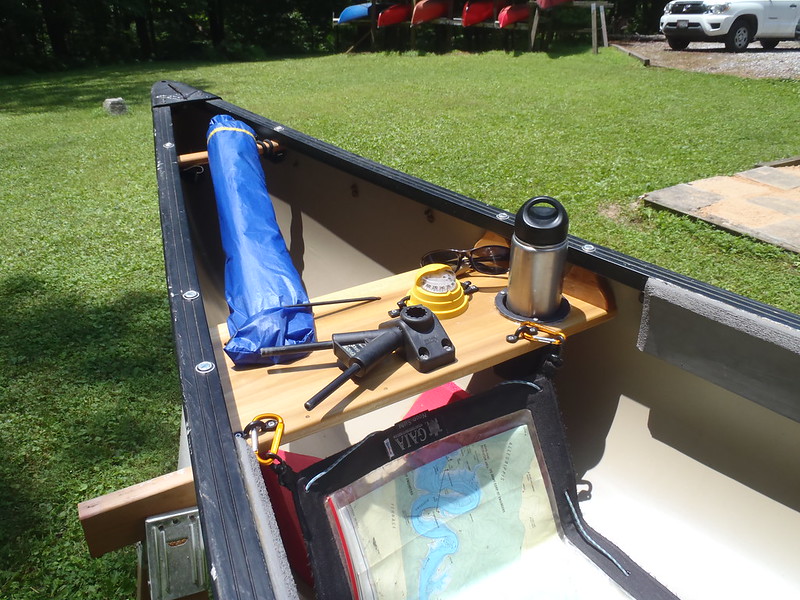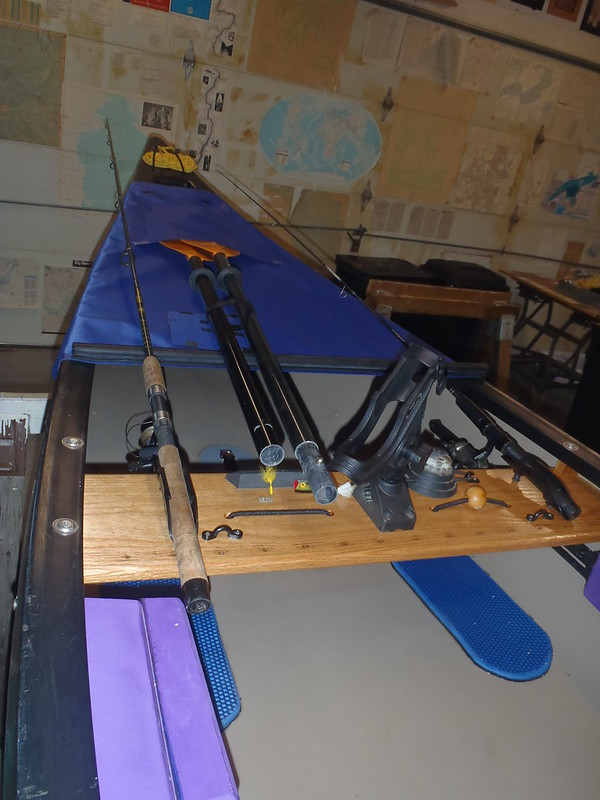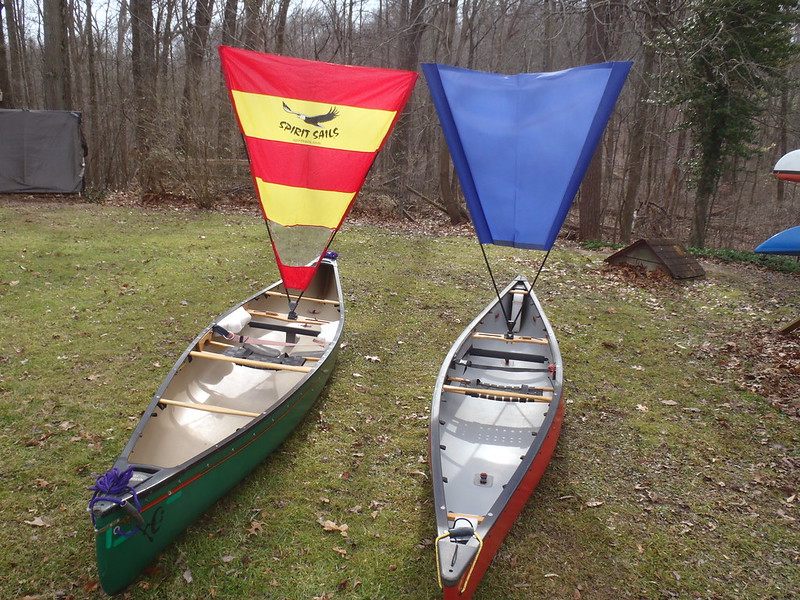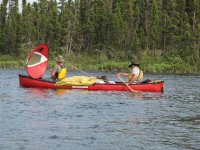G
Guest
Guest
I took this to a new thread, so it doesn’t wander lost at the bottom of a trip report. Mark, you’ve done stepped in it now, getting me talking about downwind sails and outfitting.
The video Mark mentioned:
https://www.youtube.com/watch?v=jU2mE83Gi0M
First, note that there is but light wind in that video, and Joel is cruising along at a decent “paddling” speed. Actually, with the water that shallow, better speed than he could make using just the last couple inches of the paddle blade.
EDIT: At about the 4:30 mark in that video, where Joel is struggling to turn sharp left under sail, my bad. I did not give him sufficient operating instructions, and he didn’t know how to pivot the sail for broad reach breezes. He made it through, but had he turned the sail 30 degrees it would have been a lot easier.
With a better tailwind the boat will move along smartly; if it is waveychoppy the hull actually becomes more stable, moving at (or slightly beyond) following wave speed and settling in. A 10, maybe 12 MPH tailwind with the mid-sized Spirit Sail will start to throw a little bow wake, but settle down rock steady in the waves.
 P4070917 by Mike McCrea, on Flickr
P4070917 by Mike McCrea, on Flickr
To answer Mark’s questions, the Y piece plugs into the Scotty rod base mount, and has some ridges around the bottom that match ridges inside the Scotty Base mount. The Y piece slips into the base mount at 90 degrees and, once the Y is pivoted to 0 degree (straight downwind) or 30 degree/60 degree (broad reach from either side) sailing angles, it is locked in place and can’t be fully removed without turning the Y back to the 90 degree position.
Hard to explain, hope that made sense. The various Scotty rod mounts that plug into that base mount work the same; plugged and “locked” in place with 0/30/60 degree adjustment angles. At those 0, 30 and even 60 degree downwind angles there isn’t much need for a leeboard and the canoe isn’t skating sideways enough to be beyond route calculation ken.
About the “downwind only” sailing aspect; I am a wussy canoe sailer. I have no desire to sail upwind on a trip, zig-zagging my way across open water, risking my gear load further and further from shore hiked out into the wind, travelling 20 miles to make 10. And I really don’t want the complication of designing, making, outfitting and carrying a mast, mast step, lee board, sheets & cleats.
And, mostly, putting ashore to install all that jizzwhack only to spend 3 minutes sailing before the wind dies. When that happens with the Spirit Sail it takes only a couple of seconds to dismount the sail and put it away, and paddle on while still in the canoe.
I’d rather just paddle into the dang wind, find some wind shadow and strategize a protected route behind islands and peninsulas. But dammit, when I do have a tailwind I want some simple, effective sail I can put up and take down in seconds. In light and variable winds I may put that sail up - breeze is freshening - and take it down – breeze died - multiple times.
Great minds think alike:
https://myccr.com/phpbbforum/viewtop...+mount#p411879
The toothy plastic piece on either of those Scotty bases for a DIY Y is almost certainly strong enough. The Spirit Sail Y, and all of the Scotty rod holder variations, use an identical shape and the same plastic (nylon, ? material). The weak point might be the arms of the DIY’ed Y piece, and how sturdily they are affixed to that adapted piece that plugs into the base mount.
Here’s a photo kinda down inside the re-badged Scotty base mount. The bottom of the Y piece has corresponding ridges & grooves that hold it at the chosen angle.
 PC260036 by Mike McCrea, on Flickr
PC260036 by Mike McCrea, on Flickr
The Scotty base mount has those same grooves and ridges on the side (for side mounted rod holders), so the Y plugs securely in place horizontally when not in use.
You can see the exposed bottom of the Y piece here (and how well old Timberline poles fit on the Y arms).
 P1130027 by Mike McCrea, on Flickr
P1130027 by Mike McCrea, on Flickr
BTW, the Spirit Sail Y’s do not float. Guess how I know. Guess why I have minicel floatation now glued to all but one of the Y’s, keeping that one an unsullied virgin as a scanable model in case I ever try the 3-D printing route. A 3-D printed version, if the 3-D material is sturdy enough, might be the best/easiest solution, even if cost-per only made sense having a half dozen Y pieces “printed”. The rest of the sail parts, base, batten poles and fabric, are readily available.
 P7140005 by Mike McCrea, on Flickr
P7140005 by Mike McCrea, on Flickr
I like those downwind vee sails so much – we have a families worth, plus a couple DIY loaners with original equipment Y’s - that we have a permanently installed utility thwarts with that base mount on almost every boat. Those are easy enough to DIY as clamp-on utility thwarts before doing anything permanent, even made as adjustable-width “universal” utility thwarts, a la an adjustable width clamp-on yoke.
 PC071386 by Mike McCrea, on Flickr
PC071386 by Mike McCrea, on Flickr
We used those clamp-on versions in a few boats before deciding that a multi-functional “utility thwart” was something that I always wanted present. Sail mount, compass mount, some bungee, maybe some pad eyes for a map case, etc.
The utility thwart in the Fishfider incorporates a wedge of minicel to hold hooks and lures, and a stamp numbered scale in 2” increments for measuring fish.
 P1200025 by Mike McCrea, on Flickr
P1200025 by Mike McCrea, on Flickr
(If I ever catch a fish larger than 30” I’ll let you know. Or catch any fish)
There is benefit to using carbon fiber tubes for the battens on a vee sail; the carbon fiber flexes and spills excess air in sudden gusts, which make for a smoother, less uh-oh ride, especially with the sail turned 30 or 60 degrees on a broad reach.
I have made several DIY’ed Spirit Sail copies, variously using carbon fiber tubes, aluminum Eureka tent poles and even rigid stainless steel pipe tubing. Sailing with the family on Tangier Sound; two of these three sails are DIY’s. Eh, those two DIY’s did not have see-through windows. Bad Mike. Bad, illegal Mike (didn’t know, didn’t get stopped or cited).
 IMG011 by Mike McCrea, on Flickr
IMG011 by Mike McCrea, on Flickr
The “see through” window is my one complaint with those vee sails. I’m in some wonderfully scenic place, moving along effortlessly with time to appreciate the view. But the view ahead is a drippy mess seen through smeary vinyl.
That see-blurrily-through window, on a sail otherwise blocking your vision, is a (understandably) legal requirement in most places. With a mast and raised boom there is, or should be, a view ahead below the sail. With a full fabric \/ blocking your sightline, not so much. I’d kinda like to clearly see what is up ahead, and that smeary vinyl view, well, it kinda sucks; I find myself pivoting off course briefly, just for a clear, un-smeary view ahead.
On the last DIY’ed vee sail I just eliminated the see-through window altogether, ending the bottom of the sail above my sightline, and made the sail a little larger. I figure that the small area of “window” at the bottom is mostly blocked by my body when downwind sailing, so it isn’t catching much wind.
 P1130033 by Mike McCrea, on Flickr
P1130033 by Mike McCrea, on Flickr
Once again I have exceeded my allotted bandwidth blathering about canoe outfitting and sails. It’s all Mark’s fault.
Great video, it makes me want one of these even more. There's a good shot of the mounting plate and V thingy at 0:51. So the V thingy is locked at that angle and to change the angle you would have to pull it up and out? Is it locked in place in any way from underneath or does it just sit there in the hole?
The video Mark mentioned:
https://www.youtube.com/watch?v=jU2mE83Gi0M
First, note that there is but light wind in that video, and Joel is cruising along at a decent “paddling” speed. Actually, with the water that shallow, better speed than he could make using just the last couple inches of the paddle blade.
EDIT: At about the 4:30 mark in that video, where Joel is struggling to turn sharp left under sail, my bad. I did not give him sufficient operating instructions, and he didn’t know how to pivot the sail for broad reach breezes. He made it through, but had he turned the sail 30 degrees it would have been a lot easier.
With a better tailwind the boat will move along smartly; if it is waveychoppy the hull actually becomes more stable, moving at (or slightly beyond) following wave speed and settling in. A 10, maybe 12 MPH tailwind with the mid-sized Spirit Sail will start to throw a little bow wake, but settle down rock steady in the waves.
 P4070917 by Mike McCrea, on Flickr
P4070917 by Mike McCrea, on FlickrTo answer Mark’s questions, the Y piece plugs into the Scotty rod base mount, and has some ridges around the bottom that match ridges inside the Scotty Base mount. The Y piece slips into the base mount at 90 degrees and, once the Y is pivoted to 0 degree (straight downwind) or 30 degree/60 degree (broad reach from either side) sailing angles, it is locked in place and can’t be fully removed without turning the Y back to the 90 degree position.
Hard to explain, hope that made sense. The various Scotty rod mounts that plug into that base mount work the same; plugged and “locked” in place with 0/30/60 degree adjustment angles. At those 0, 30 and even 60 degree downwind angles there isn’t much need for a leeboard and the canoe isn’t skating sideways enough to be beyond route calculation ken.
About the “downwind only” sailing aspect; I am a wussy canoe sailer. I have no desire to sail upwind on a trip, zig-zagging my way across open water, risking my gear load further and further from shore hiked out into the wind, travelling 20 miles to make 10. And I really don’t want the complication of designing, making, outfitting and carrying a mast, mast step, lee board, sheets & cleats.
And, mostly, putting ashore to install all that jizzwhack only to spend 3 minutes sailing before the wind dies. When that happens with the Spirit Sail it takes only a couple of seconds to dismount the sail and put it away, and paddle on while still in the canoe.
I’d rather just paddle into the dang wind, find some wind shadow and strategize a protected route behind islands and peninsulas. But dammit, when I do have a tailwind I want some simple, effective sail I can put up and take down in seconds. In light and variable winds I may put that sail up - breeze is freshening - and take it down – breeze died - multiple times.
Here's a universal mount I found on the Scotty web site. I think I could make something to hold the battens out of wood, maybe slathered with fiberglass and epoxy that would hold up, but I wonder if the rest of this is up to the task. Do you think the plastic is strong enough? I see they also have a flush mount that might be able to take the torque a bit better. I guess the weak point would be the "pin" that sits in the mount.
I found this setup on the website, it comes with both pieces. The mount looks a bit more stout since it is recessed into the base. I'm thinking small block of hardwood shaped in a V. Question is whether the insert is strong enough? It looks pretty solid and I assume will withstand the torque from a fishing rod with more leverage. Only $20. It's in my shopping cart.
Great minds think alike:
https://myccr.com/phpbbforum/viewtop...+mount#p411879
The toothy plastic piece on either of those Scotty bases for a DIY Y is almost certainly strong enough. The Spirit Sail Y, and all of the Scotty rod holder variations, use an identical shape and the same plastic (nylon, ? material). The weak point might be the arms of the DIY’ed Y piece, and how sturdily they are affixed to that adapted piece that plugs into the base mount.
Here’s a photo kinda down inside the re-badged Scotty base mount. The bottom of the Y piece has corresponding ridges & grooves that hold it at the chosen angle.
 PC260036 by Mike McCrea, on Flickr
PC260036 by Mike McCrea, on FlickrThe Scotty base mount has those same grooves and ridges on the side (for side mounted rod holders), so the Y plugs securely in place horizontally when not in use.
You can see the exposed bottom of the Y piece here (and how well old Timberline poles fit on the Y arms).
 P1130027 by Mike McCrea, on Flickr
P1130027 by Mike McCrea, on FlickrBTW, the Spirit Sail Y’s do not float. Guess how I know. Guess why I have minicel floatation now glued to all but one of the Y’s, keeping that one an unsullied virgin as a scanable model in case I ever try the 3-D printing route. A 3-D printed version, if the 3-D material is sturdy enough, might be the best/easiest solution, even if cost-per only made sense having a half dozen Y pieces “printed”. The rest of the sail parts, base, batten poles and fabric, are readily available.
 P7140005 by Mike McCrea, on Flickr
P7140005 by Mike McCrea, on FlickrI like those downwind vee sails so much – we have a families worth, plus a couple DIY loaners with original equipment Y’s - that we have a permanently installed utility thwarts with that base mount on almost every boat. Those are easy enough to DIY as clamp-on utility thwarts before doing anything permanent, even made as adjustable-width “universal” utility thwarts, a la an adjustable width clamp-on yoke.
 PC071386 by Mike McCrea, on Flickr
PC071386 by Mike McCrea, on FlickrWe used those clamp-on versions in a few boats before deciding that a multi-functional “utility thwart” was something that I always wanted present. Sail mount, compass mount, some bungee, maybe some pad eyes for a map case, etc.
The utility thwart in the Fishfider incorporates a wedge of minicel to hold hooks and lures, and a stamp numbered scale in 2” increments for measuring fish.
 P1200025 by Mike McCrea, on Flickr
P1200025 by Mike McCrea, on Flickr(If I ever catch a fish larger than 30” I’ll let you know. Or catch any fish)
I have lots of tent poles and piles of fabric, but none of the see through stuff.
There is benefit to using carbon fiber tubes for the battens on a vee sail; the carbon fiber flexes and spills excess air in sudden gusts, which make for a smoother, less uh-oh ride, especially with the sail turned 30 or 60 degrees on a broad reach.
I have made several DIY’ed Spirit Sail copies, variously using carbon fiber tubes, aluminum Eureka tent poles and even rigid stainless steel pipe tubing. Sailing with the family on Tangier Sound; two of these three sails are DIY’s. Eh, those two DIY’s did not have see-through windows. Bad Mike. Bad, illegal Mike (didn’t know, didn’t get stopped or cited).
 IMG011 by Mike McCrea, on Flickr
IMG011 by Mike McCrea, on FlickrThe “see through” window is my one complaint with those vee sails. I’m in some wonderfully scenic place, moving along effortlessly with time to appreciate the view. But the view ahead is a drippy mess seen through smeary vinyl.
That see-blurrily-through window, on a sail otherwise blocking your vision, is a (understandably) legal requirement in most places. With a mast and raised boom there is, or should be, a view ahead below the sail. With a full fabric \/ blocking your sightline, not so much. I’d kinda like to clearly see what is up ahead, and that smeary vinyl view, well, it kinda sucks; I find myself pivoting off course briefly, just for a clear, un-smeary view ahead.
On the last DIY’ed vee sail I just eliminated the see-through window altogether, ending the bottom of the sail above my sightline, and made the sail a little larger. I figure that the small area of “window” at the bottom is mostly blocked by my body when downwind sailing, so it isn’t catching much wind.
 P1130033 by Mike McCrea, on Flickr
P1130033 by Mike McCrea, on FlickrOnce again I have exceeded my allotted bandwidth blathering about canoe outfitting and sails. It’s all Mark’s fault.
Last edited:





